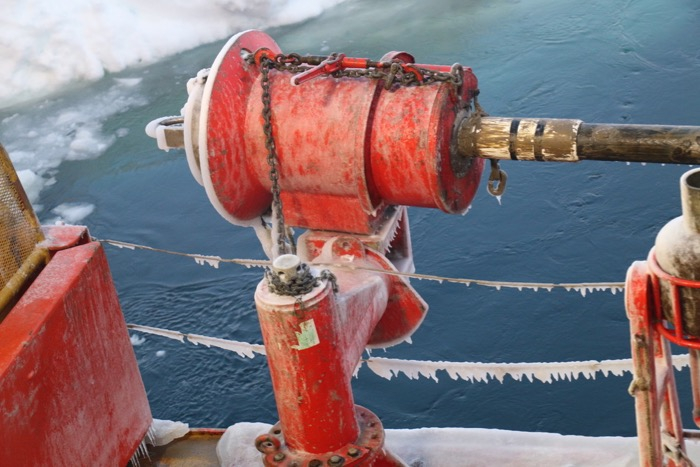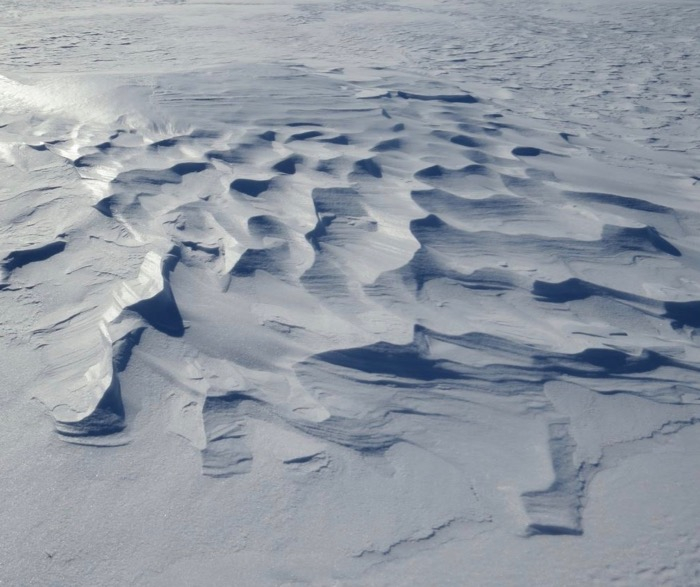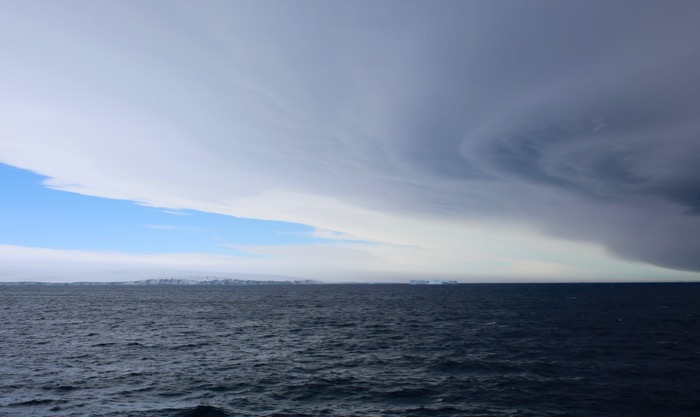An Unstoppable Force
If Antarctica were ever to have its own professional sports team, it would absolutely be called the Wind, and its tagline would be "An Unstoppable Force." The Antarctic winds have been our constant companion throughout the course of this expedition, and have affected nearly every aspect of our lives. The wind whips up waves and causes the captain to order all passengers to stay inside. It stops us from collecting sediment or surveying the seafloor with sonar. It sends me bumping into walls and careening down corridors as I try to get back to my bunk to lie down after the wind-induced waves lead to overwhelming seasickness. It also pushes around the ice, sometimes clearing a path for the ship and sometimes pushing big bergs right where we need to go. The wind drops the apparent air temperature by twenty degrees when it is really blowing, freezing the droplets it lifts off the waves onto every exposed surface.

The katabatic winds are not specific to Antarctica, but they blow more strongly here than they do anywhere else on Earth - top wind speeds in Antarctica were clocked at 200 miles per hour (320 km/hr) - to put that number in context, wind speeds of only 157 mph are all that is necessary for a storm to qualify as a Category 5 hurricane. Katabatic winds get their start on the elevated mountain areas in the interior of the continent. Bitter cold air in the high regions flows downhill under the force of gravity and spreads out toward the coasts. While the katabatic winds rarely reach speeds close to 200 mph, they are nearly always blowing to some extent. The ice is the predominant force sculpting the shape of the land, but the wind has a major impact on the human experience in Antarctica. Sastrugi are ridges formed in hard-packed snow created by the constant battering of the katabatic winds. The Dry Valleys near McMurdo Station have been stripped of all moisture and snow cover by the persistent winds. While snow doesn't fall exceptionally often on the continent, wind-blown snow is almost always in motion, sometimes making it seem like a blizzard when barely any snow is actually falling.

There are other winds that are shaping Antarctica - winds that don't originate at the high points of the massive ice sheets that cover the continent, winds that are partially responsible for the accelerated rate of melting that is putting so many of us at risk. Recent research by Paul Holland and others at the British Antarctic Survey shows that wind also plays a major role in bringing the warm CircumpolarLocated or found within the Earth’s polar regions. Deep Water (CDW) up to the face of Thwaites GlacierA mass of ice that persists for many years and notably deforms and flows under the influence of gravity. - but you have to zoom out a little in order to understand the connection. Although the CDW is warm, it hasn't been created by any change in climate caused by human activities. In fact, water in the CDW hasn't had contact with the atmosphere for thousands of years. It has been down there, slightly warmer than the surrounding Southern Ocean, for a long, long time. But the wind patterns near Antarctica affect the flow of the CDW, and those wind patterns have altered along with the climate. In an article titled "The Reason Antarctica is Melting: Shifting Winds, Driven by Global Warming" in Scientific American, author Annie Sneed writes: "The reason climate change is causing this shift is because of the fundamental way wind works on the earth and responds to warming, Holland says. The earth’s surface is warming unevenly, which influences where areas of high and low pressure are situated in the atmosphere overhead. Because winds flow between those highs and lows, warming affects the broad patterns of winds across the globe. In West Antarctica, warming is shifting a key band of winds southward and making it stronger, which ultimately causes the winds over the Amundsen Sea to blow east."

I include information about the wind in the "Weather" section along the right-hand side of most of my recent blog posts, and if you look back through them, the most frequent wind direction is out of the east. This isn't a big enough data set to confirm what Dr. Holland and others reported, but it certainly seems like my observations follow the trend they found.
For Further Exploration
BrainPop has a lesson designed for 5th-8th graders that helps them understand the effect of pressure systems on wind - check it out here. There are also so many ways for classes or individuals to design their own wind turbines, including the KidWind Challenge, a national competition for middle and high school students to build and test a wind turbine and to explore the benefits and limitations of renewable energy. My friend Kelli combines the KidWind Challenge with the book The Boy Who Harnessed the Wind by William Kamkwamba to create a curriculum that spans multiple subjects in school and helps students understand the practical applications of wind technology.


Comments